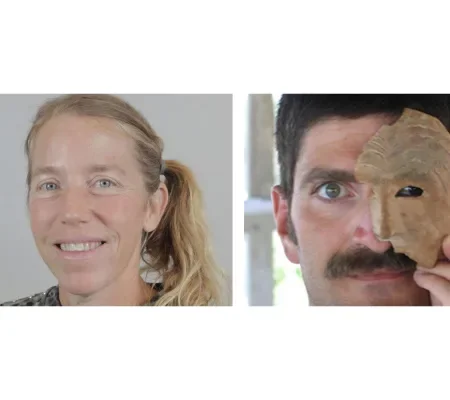The University of Texas at Austin Department of Art and Art History has announced that Kristin Lucas and Nassos Papalexandrou have been granted tenure. Lucas has been promoted to Associate Professor of Studio Art and Papalexandrou has been promoted to full Professor of Art History.
Lucas attended The Cooper Union School of Art for her BFA before completing her MFA in Art Practice at Stanford University. She is an artist who works across media and reality. She is a member of NEW INC, a museum-led cultural incubator for art, technology and design; and works collaboratively with StoriesXFuture, an international working group of sustainability experts, technologists and storytellers exploring the potential of emerging technologies like XR and AI to foster positive impact, and to accelerate the transition to greener, more resilient cities. As recently as 2020, she served as a participant in SciArt Initiative’s The Bridge Collaborative Residency Program. In a 2018 review of Lucas' ongoing Flarmingos augmented (AR) and mixed reality (MR) technologies project, Hyperallergic critic Allison Meier wrote, "Lucas has often used digital art and technology to question and enhance reality, particularly as it relates to the human body, whether legally changing her name to her own name in 2007 to refresh herself like a web page, or the interactive 2015 “Sole Soaker,” which involved a virtual environment with a roller coaster for pedestrians."
Her augmented reality, generative animation, video, installation, and performance works are in the collections of major institutions, including the Museum of Modern Art and the Dia Center for the Arts; and she has performed and exhibited at the MoMA, the New Museum, the Guggenheim, the Whitney, the Foundation for Art and Creative Technology, and the Center for Art and Media, among others.
Papalexandrou, whose Ph.D. in Classical Art and Archaeology is from Princeton, joined the UT departmental faculty as an assistant professor in 2002. He specializes in pre-classical Greek visual culture in a broader Mediterranean context, with a strong through-line of research on connections between Greece and the Near East. His most recent book, Bronze Monsters and the Cultures of Wonder in the Preclassical Mediterranean (UT Press, November 2021) is an enlightening study of griffin cauldrons in the preclassical Mediterranean, uncovering the origins of illusionism in Greek art and exploring the social significance of a changing visual culture. In a review of the book, Princeton Associate Professor of Classical Archaeology Nathan T. Arrington wrote, “Papalexandrou presents a riveting body of material, griffin cauldrons, which have never received sustained discussion as a Mediterranean-wide phenomenon of the seventh century BCE. His treatment is comprehensive, with archaeological contexts discussed in detail. In addition, he astutely looks at the depiction of cauldrons in other media and contextualizes them in terms of literary references to artwork. This is a bold and creative book, rich in its interpretations and readings.”
Papalexandrou offers undergraduate classes on various aspects of Greek Art and Archaeology (Myth in Images in Greek and Roman Antiquity; Art and Archaeology of Greek Sanctuaries; The Parthenon throughout the Ages; Visual Cultures of Cyprus, Crete, and Sicily). He also offers courses on the Art and Archaeology of the Ancient Near East. His graduate seminars explore various themes regarding the Art and Culture of Early Greece, the Eastern Mediterranean (11-6 centuries BCE), and the Near East (Orientalizing Phenomenon; Art as a Means of Communication in Preliterate Societies; Visual Cultures of the Ancient Near East). In the 90s Papalexandrou excavated a large public building of Cypro-Archaic date (ca. late 6th c. BCE) at Polis tis Chysochou (Marion), Cyprus and he is now involved in the publication of this unique find.


